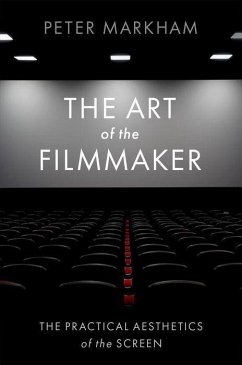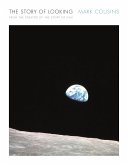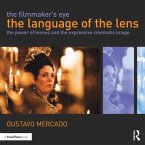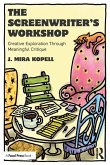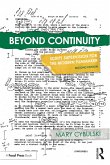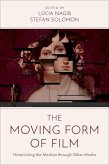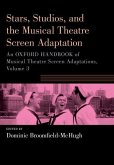- Broschiertes Buch
- Merkliste
- Auf die Merkliste
- Bewerten Bewerten
- Teilen
- Produkt teilen
- Produkterinnerung
- Produkterinnerung
The Art of the Filmmaker: The Practical Aesthetics of the Screen explores the filmmaker's intention and method, their creation and capture of the fiction on the screen, and their formulation of the elements of the frame as a designed address to the audience. Written in accessible language and generously illustrated with film stills, this book is essential reading for film students and practitioners alike.
Andere Kunden interessierten sich auch für
![The Story of Looking The Story of Looking]() Mark CousinsThe Story of Looking19,99 €
Mark CousinsThe Story of Looking19,99 €![The Filmmaker's Eye: The Language of the Lens The Filmmaker's Eye: The Language of the Lens]() Gustavo MercadoThe Filmmaker's Eye: The Language of the Lens48,99 €
Gustavo MercadoThe Filmmaker's Eye: The Language of the Lens48,99 €![The Screenwriter's Workshop The Screenwriter's Workshop]() J. Mira KopellThe Screenwriter's Workshop42,99 €
J. Mira KopellThe Screenwriter's Workshop42,99 €![Beyond Continuity Beyond Continuity]() Mary CybulskiBeyond Continuity35,99 €
Mary CybulskiBeyond Continuity35,99 €![Film Psychoanalysis Film Psychoanalysis]() Andreas HamburgerFilm Psychoanalysis147,99 €
Andreas HamburgerFilm Psychoanalysis147,99 €![The Moving Form of Film The Moving Form of Film]() The Moving Form of Film46,99 €
The Moving Form of Film46,99 €![Stars, Studios, and the Musical Theatre Screen Adaptation Stars, Studios, and the Musical Theatre Screen Adaptation]() Stars, Studios, and the Musical Theatre Screen Adaptation38,99 €
Stars, Studios, and the Musical Theatre Screen Adaptation38,99 €-
-
The Art of the Filmmaker: The Practical Aesthetics of the Screen explores the filmmaker's intention and method, their creation and capture of the fiction on the screen, and their formulation of the elements of the frame as a designed address to the audience. Written in accessible language and generously illustrated with film stills, this book is essential reading for film students and practitioners alike.
Produktdetails
- Produktdetails
- Verlag: Oxford University Press Inc
- Seitenzahl: 344
- Erscheinungstermin: 13. Oktober 2023
- Englisch
- Abmessung: 231mm x 152mm x 20mm
- Gewicht: 506g
- ISBN-13: 9780197631539
- ISBN-10: 0197631533
- Artikelnr.: 67864979
- Herstellerkennzeichnung
- Libri GmbH
- Europaallee 1
- 36244 Bad Hersfeld
- gpsr@libri.de
- Verlag: Oxford University Press Inc
- Seitenzahl: 344
- Erscheinungstermin: 13. Oktober 2023
- Englisch
- Abmessung: 231mm x 152mm x 20mm
- Gewicht: 506g
- ISBN-13: 9780197631539
- ISBN-10: 0197631533
- Artikelnr.: 67864979
- Herstellerkennzeichnung
- Libri GmbH
- Europaallee 1
- 36244 Bad Hersfeld
- gpsr@libri.de
After a career in production with BBC TV Drama and Films, working with filmmakers such as Anthony Minghella and Martin Scorsese, and directing in Film and TV, Peter Markham was head of the MFA directing program at the AFI Conservatory, Los Angeles. He has taught in Beijing and Shanghai, been a lead instructor with Sundance Collab, and is a consultant and educator in creative filmmaking. He is the author of What's the Story? The Director Meets Their Screenplay: An Essential Guide for Directors and Writer-Directors (2020).
* Acknowledgments * Introduction * PART ONE: PERSPECTIVES * CHAPTER ONE Appreciating the Art of The Filmmaker. * CHAPTER TWO Language and Cinema. * Definitions of Language
Visual vs. Pictorial Films
Cinematic Language as Theft. * CHAPTER THREE The 'Five Domains in Which a Film 'Comes to Life.'' * The Fiction
The Screen
The 'Screen of the Mind'
The Audience (Heart
Mind
Guts)
Audience Memory. * CHAPTER FOUR The 'Five Tasks' of the Filmmaker. * Information
Emotion
Visceral/Tactile/Neural Sensation
Vision
Storytelling. * The 'Two Vectors' of the Filmmaker * PART TWO: CRITERIA * CHAPTER FIVE Dramatic Narrative. * Story
Structure
'Narrative Units'
Characters
World. * CHAPTER SIX The Elements Before the Lens. * Sets and Locations
Actors and Staging
Performance
Props and Equipment. * CHAPTER SEVEN Screen Language. * Grammar and Language
Visual Language-Meaning through Use vs. Meaning inherent in the Language
Ikones
Color
Eye Trace
Uninflected vs. Inflected Cinematic Language
The Image
Visual Language
and Style. * CHAPTER EIGHT The Shot. * Composition and Mise-en-Scène
Aspect Ratio
Selection
Establishing Shots and Masters
Subject
Size
Framing. * CHAPTER NINE Camera. * Camera as Concept
Placement and Angle (Frontal
Profiles and Half-Profiles
Back Shots
Raking Angles
Top Shots
'Dutched' Angles
Angles on the Axis of the Drama)
Camera Movement (x-
y-
z-axes
Editing in Camera
Narrative Moves
Descriptive Moves
Pivots)
Lensing (Depth of Field
Wide
Neutral
Long
Spherical
Anamorphic
Modulation of Space). * CHAPTER TEN Editing: the Nature of Cuts and Transitions. * Editorial Art
Walter Murch's Criteria for Making the Cut
Narrative Point of View
Modulation of Time and Space
Transitions. * CHAPTER ELEVEN Sound
Music
and the Screen. * Sound: Verisimilitude
The 'Screen of the Mind'
Narrative Point of View
Subliminal Messaging
Tonal Dissonance and Irony
Register
Immersive Experience
Silence. * Music: Diegetic
Non-diegetic
Verisimilitude
Narrative POV and Subliminal Messaging
Tonal Dissonance and Irony
Register
Immersive Experience. * CHAPTER TWELVE Reading the Screenplay. * PART THREE: THE ART OF THE FILMMAKER: THE CASE STUDIES * The Filmmakers * Ari Aster: Hereditary * The Prelude * The Dinner Scene * The Family Séance * Barry Jenkins: Moonlight * Announcing Little * Announcing Chiron * Announcing Black * Chloe Zhao: Nomadland * Empire-Opening and Ending * Storytelling from Life
from the Filmmaker
Resonance from Nature * Fern and Dave-Invitation and Departure * CONCLUSION * Glossary of Abbreviations * Bibliography * Filmography * Index
Visual vs. Pictorial Films
Cinematic Language as Theft. * CHAPTER THREE The 'Five Domains in Which a Film 'Comes to Life.'' * The Fiction
The Screen
The 'Screen of the Mind'
The Audience (Heart
Mind
Guts)
Audience Memory. * CHAPTER FOUR The 'Five Tasks' of the Filmmaker. * Information
Emotion
Visceral/Tactile/Neural Sensation
Vision
Storytelling. * The 'Two Vectors' of the Filmmaker * PART TWO: CRITERIA * CHAPTER FIVE Dramatic Narrative. * Story
Structure
'Narrative Units'
Characters
World. * CHAPTER SIX The Elements Before the Lens. * Sets and Locations
Actors and Staging
Performance
Props and Equipment. * CHAPTER SEVEN Screen Language. * Grammar and Language
Visual Language-Meaning through Use vs. Meaning inherent in the Language
Ikones
Color
Eye Trace
Uninflected vs. Inflected Cinematic Language
The Image
Visual Language
and Style. * CHAPTER EIGHT The Shot. * Composition and Mise-en-Scène
Aspect Ratio
Selection
Establishing Shots and Masters
Subject
Size
Framing. * CHAPTER NINE Camera. * Camera as Concept
Placement and Angle (Frontal
Profiles and Half-Profiles
Back Shots
Raking Angles
Top Shots
'Dutched' Angles
Angles on the Axis of the Drama)
Camera Movement (x-
y-
z-axes
Editing in Camera
Narrative Moves
Descriptive Moves
Pivots)
Lensing (Depth of Field
Wide
Neutral
Long
Spherical
Anamorphic
Modulation of Space). * CHAPTER TEN Editing: the Nature of Cuts and Transitions. * Editorial Art
Walter Murch's Criteria for Making the Cut
Narrative Point of View
Modulation of Time and Space
Transitions. * CHAPTER ELEVEN Sound
Music
and the Screen. * Sound: Verisimilitude
The 'Screen of the Mind'
Narrative Point of View
Subliminal Messaging
Tonal Dissonance and Irony
Register
Immersive Experience
Silence. * Music: Diegetic
Non-diegetic
Verisimilitude
Narrative POV and Subliminal Messaging
Tonal Dissonance and Irony
Register
Immersive Experience. * CHAPTER TWELVE Reading the Screenplay. * PART THREE: THE ART OF THE FILMMAKER: THE CASE STUDIES * The Filmmakers * Ari Aster: Hereditary * The Prelude * The Dinner Scene * The Family Séance * Barry Jenkins: Moonlight * Announcing Little * Announcing Chiron * Announcing Black * Chloe Zhao: Nomadland * Empire-Opening and Ending * Storytelling from Life
from the Filmmaker
Resonance from Nature * Fern and Dave-Invitation and Departure * CONCLUSION * Glossary of Abbreviations * Bibliography * Filmography * Index
* Acknowledgments * Introduction * PART ONE: PERSPECTIVES * CHAPTER ONE Appreciating the Art of The Filmmaker. * CHAPTER TWO Language and Cinema. * Definitions of Language
Visual vs. Pictorial Films
Cinematic Language as Theft. * CHAPTER THREE The 'Five Domains in Which a Film 'Comes to Life.'' * The Fiction
The Screen
The 'Screen of the Mind'
The Audience (Heart
Mind
Guts)
Audience Memory. * CHAPTER FOUR The 'Five Tasks' of the Filmmaker. * Information
Emotion
Visceral/Tactile/Neural Sensation
Vision
Storytelling. * The 'Two Vectors' of the Filmmaker * PART TWO: CRITERIA * CHAPTER FIVE Dramatic Narrative. * Story
Structure
'Narrative Units'
Characters
World. * CHAPTER SIX The Elements Before the Lens. * Sets and Locations
Actors and Staging
Performance
Props and Equipment. * CHAPTER SEVEN Screen Language. * Grammar and Language
Visual Language-Meaning through Use vs. Meaning inherent in the Language
Ikones
Color
Eye Trace
Uninflected vs. Inflected Cinematic Language
The Image
Visual Language
and Style. * CHAPTER EIGHT The Shot. * Composition and Mise-en-Scène
Aspect Ratio
Selection
Establishing Shots and Masters
Subject
Size
Framing. * CHAPTER NINE Camera. * Camera as Concept
Placement and Angle (Frontal
Profiles and Half-Profiles
Back Shots
Raking Angles
Top Shots
'Dutched' Angles
Angles on the Axis of the Drama)
Camera Movement (x-
y-
z-axes
Editing in Camera
Narrative Moves
Descriptive Moves
Pivots)
Lensing (Depth of Field
Wide
Neutral
Long
Spherical
Anamorphic
Modulation of Space). * CHAPTER TEN Editing: the Nature of Cuts and Transitions. * Editorial Art
Walter Murch's Criteria for Making the Cut
Narrative Point of View
Modulation of Time and Space
Transitions. * CHAPTER ELEVEN Sound
Music
and the Screen. * Sound: Verisimilitude
The 'Screen of the Mind'
Narrative Point of View
Subliminal Messaging
Tonal Dissonance and Irony
Register
Immersive Experience
Silence. * Music: Diegetic
Non-diegetic
Verisimilitude
Narrative POV and Subliminal Messaging
Tonal Dissonance and Irony
Register
Immersive Experience. * CHAPTER TWELVE Reading the Screenplay. * PART THREE: THE ART OF THE FILMMAKER: THE CASE STUDIES * The Filmmakers * Ari Aster: Hereditary * The Prelude * The Dinner Scene * The Family Séance * Barry Jenkins: Moonlight * Announcing Little * Announcing Chiron * Announcing Black * Chloe Zhao: Nomadland * Empire-Opening and Ending * Storytelling from Life
from the Filmmaker
Resonance from Nature * Fern and Dave-Invitation and Departure * CONCLUSION * Glossary of Abbreviations * Bibliography * Filmography * Index
Visual vs. Pictorial Films
Cinematic Language as Theft. * CHAPTER THREE The 'Five Domains in Which a Film 'Comes to Life.'' * The Fiction
The Screen
The 'Screen of the Mind'
The Audience (Heart
Mind
Guts)
Audience Memory. * CHAPTER FOUR The 'Five Tasks' of the Filmmaker. * Information
Emotion
Visceral/Tactile/Neural Sensation
Vision
Storytelling. * The 'Two Vectors' of the Filmmaker * PART TWO: CRITERIA * CHAPTER FIVE Dramatic Narrative. * Story
Structure
'Narrative Units'
Characters
World. * CHAPTER SIX The Elements Before the Lens. * Sets and Locations
Actors and Staging
Performance
Props and Equipment. * CHAPTER SEVEN Screen Language. * Grammar and Language
Visual Language-Meaning through Use vs. Meaning inherent in the Language
Ikones
Color
Eye Trace
Uninflected vs. Inflected Cinematic Language
The Image
Visual Language
and Style. * CHAPTER EIGHT The Shot. * Composition and Mise-en-Scène
Aspect Ratio
Selection
Establishing Shots and Masters
Subject
Size
Framing. * CHAPTER NINE Camera. * Camera as Concept
Placement and Angle (Frontal
Profiles and Half-Profiles
Back Shots
Raking Angles
Top Shots
'Dutched' Angles
Angles on the Axis of the Drama)
Camera Movement (x-
y-
z-axes
Editing in Camera
Narrative Moves
Descriptive Moves
Pivots)
Lensing (Depth of Field
Wide
Neutral
Long
Spherical
Anamorphic
Modulation of Space). * CHAPTER TEN Editing: the Nature of Cuts and Transitions. * Editorial Art
Walter Murch's Criteria for Making the Cut
Narrative Point of View
Modulation of Time and Space
Transitions. * CHAPTER ELEVEN Sound
Music
and the Screen. * Sound: Verisimilitude
The 'Screen of the Mind'
Narrative Point of View
Subliminal Messaging
Tonal Dissonance and Irony
Register
Immersive Experience
Silence. * Music: Diegetic
Non-diegetic
Verisimilitude
Narrative POV and Subliminal Messaging
Tonal Dissonance and Irony
Register
Immersive Experience. * CHAPTER TWELVE Reading the Screenplay. * PART THREE: THE ART OF THE FILMMAKER: THE CASE STUDIES * The Filmmakers * Ari Aster: Hereditary * The Prelude * The Dinner Scene * The Family Séance * Barry Jenkins: Moonlight * Announcing Little * Announcing Chiron * Announcing Black * Chloe Zhao: Nomadland * Empire-Opening and Ending * Storytelling from Life
from the Filmmaker
Resonance from Nature * Fern and Dave-Invitation and Departure * CONCLUSION * Glossary of Abbreviations * Bibliography * Filmography * Index

